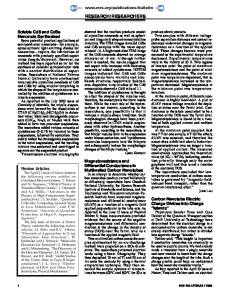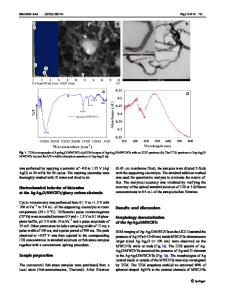Wet-spinning fabrication of multi-walled carbon nanotubes reinforced poly(3,4-ethylenedioxythiophene)-poly(styrenesulfon
- PDF / 2,638,102 Bytes
- 16 Pages / 595.276 x 790.866 pts Page_size
- 34 Downloads / 252 Views
Wet-spinning fabrication of multi-walled carbon nanotubes reinforced poly(3,4ethylenedioxythiophene)-poly(styrenesulfonate) hybrid fibers for high-performance fiber-shaped supercapacitor Chen Meng1,3, Yong Qian1,3, Jinxin He1,2, and Xia Dong1,3,* 1
College of Chemistry, Chemical Engineering and Biotechnology, Donghua University, Shanghai 201620, People’s Republic of China Key Laboratory of Textile Science & Technology, Ministry of Education, Shanghai 201620, People’s Republic of China 3 National Engineering Research Center for Dyeing and Finishing of Textile, Donghua University, Shanghai 201620, People’s Republic of China 2
Received: 23 July 2020
ABSTRACT
Accepted: 8 September 2020
Fiber-shaped supercapacitors with high energy density and power density are promising as energy storage device for flexible electronics because of their onedimensional distinct structure, excellent flexibility and potential to be integrated. In this study, multi-walled carbon nanotubes (MWCNT)/poly(3,4ethylenedioxythiophene)-poly(styrenesulfonate) (PEDOT:PSS) hybrid fibers with different fraction of MWCNT were fabricated via wet-spinning and posttreatment process. Due to the synergistic effects of two components, the designed hybrid fibers displayed excellent conductivity and mechanical property. Furthermore, the symmetric flexible supercapacitor based on our prepared hybrid fibers possessed an impressive specific capacitance (117.0 mF/cm2 at current density 0.1 mA/cm2), superior energy/power characteristics (16.3 lWh/cm2 at power density of 0.05 mW/cm2), as well as satisfactory cycle stability (90% capacitance retention after 2000 charge/discharge cycles) and flexibility (87% capacitance retention after 1000 bending cycles). Thus, MWCNT/ PEDOT:PSS hybrid fibers are a promising candidate for constructing flexible electrochemical energy storage device.
Ó
Springer Science+Business
Media, LLC, part of Springer Nature 2020
Address correspondence to E-mail: [email protected]
https://doi.org/10.1007/s10854-020-04464-7
J Mater Sci: Mater Electron
1 Introduction In recent years, the development of energy storage device with exceptional mechanical flexibility and electrochemical performance is in high requirements with the booming advances of new generation portable and wearable electronic devices including bio-health monitor, e-skin, foldable antennas and bendable displays [1–4]. Among various energy storage systems, supercapacitors (SCs) with the merits of high energy density, rapid charge/discharge rate and long cycling life have attracted intensive research attention [5–8]. Different from conventional two-dimensional, bulky and planar supercapacitors, fiber-shaped supercapacitors (FSCs) are highly promising as an emerging power sources due to their outstanding characteristics such as good flexibility, tiny volume, light weight and wearability. Moreover, unique one-dimensional structure endows them with the great potential to be woven or knotted into different shapes and integrated with various electronic components [9–13]. There
Data Loading...











